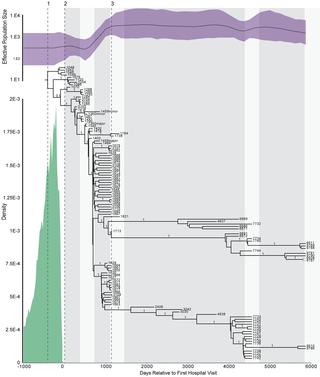PLoS Pathogens ( IF 6.7 ) Pub Date : 2020-03-05 , DOI: 10.1371/journal.ppat.1008298 Talima Pearson 1 , Jason W Sahl 1 , Crystal M Hepp 1, 2 , Karthik Handady 1 , Heidie Hornstra 1 , Adam J Vazquez 1 , Erik Settles 1 , Mark Mayo 3 , Mirjam Kaestli 3 , Charles H D Williamson 1 , Erin P Price 1 , Derek S Sarovich 1 , James M Cook 1 , Spenser R Wolken 1 , Richard A Bowen 4 , Apichai Tuanyok 1 , Jeffrey T Foster 1 , Kevin P Drees 1 , Timothy J Kidd 5 , Scott C Bell 6 , Bart J Currie 3, 7 , Paul Keim 1

|
Although acute melioidosis is the most common outcome of Burkholderia pseudomallei infection, we have documented a case, P314, where disease severity lessened with time, and the pathogen evolved towards a commensal relationship with the host. In the current study, we used whole-genome sequencing to monitor this long-term symbiotic relationship to better understand B. pseudomallei persistence in P314’s sputum despite intensive initial therapeutic regimens. We collected and sequenced 118 B. pseudomallei isolates from P314’s airways over a >16-year period, and also sampled the patient’s home environment, recovering six closely related B. pseudomallei isolates from the household water system. Using comparative genomics, we identified 126 SNPs in the core genome of the 124 isolates or 162 SNPs/indels when the accessory genome was included. The core SNPs were used to construct a phylogenetic tree, which demonstrated a close relationship between environmental and clinical isolates and detailed within-host evolutionary patterns. The phylogeny had little homoplasy, consistent with a strictly clonal mode of genetic inheritance. Repeated sampling revealed evidence of genetic diversification, but frequent extinctions left only one successful lineage through the first four years and two lineages after that. Overall, the evolution of this population is nonadaptive and best explained by genetic drift. However, some genetic and phenotypic changes are consistent with in situ adaptation. Using a mouse model, P314 isolates caused greatly reduced morbidity and mortality compared to the environmental isolates. Additionally, potentially adaptive phenotypes emerged and included differences in the O-antigen, capsular polysaccharide, motility, and colony morphology. The >13-year co-existence of two long-lived lineages presents interesting hypotheses that can be tested in future studies to provide additional insights into selective pressures, niche differentiation, and microbial adaptation. This unusual melioidosis case presents a rare example of the evolutionary progression towards commensalism by a highly virulent pathogen within a single human host.
中文翻译:

是病因?在超过16年的Burkholderia pseudomallei慢性感染中,宿主内纵向种群动态,演变和适应。
尽管急性类li虫病是假伯克霍尔德氏菌感染的最常见结局,但我们已经记录了一个病例P314,该病的严重程度随着时间的推移而降低,病原体逐渐演变为与宿主的共生关系。在目前的研究中,我们使用的全基因组测序监测这个长期的共生关系,以更好地理解乙。假单胞菌持续在P314中的痰液,尽管密集的初期治疗方案。我们收集和测序118乙。鼻疽从P314的航空公司在> 16年间隔离,并采样患者的家庭环境,恢复6个密切相关的乙。假苹果与家庭供水系统隔离。使用比较基因组学,当包括辅助基因组时,我们在124个分离株的核心基因组中鉴定了126个SNP,或者在162个SNP / indels中鉴定出。核心SNP用于构建系统发育树,该树表明环境和临床分离株与宿主内部详细的进化模式之间存在密切的关系。系统发育几乎没有同质性,与严格的遗传遗传克隆模式一致。重复取样揭示了遗传多样性的证据,但是频繁的灭绝在最初的四年中只留下了一个成功的血统,而在那之后则留下了两个成功的血统。总体而言,该种群的进化是非适应性的,最好用遗传漂移来解释。但是,某些遗传和表型变化与原位一致适应。与环境分离株相比,使用小鼠模型,P314分离株导致发病率和死亡率大大降低。另外,潜在的适应性表型出现了,并包括O-抗原,荚膜多糖,运动性和菌落形态的差异。两个长期存在的谱系的> 13年共存提出了有趣的假设,可以在以后的研究中进行检验,以提供有关选择压力,生态位分化和微生物适应的更多见解。这种不寻常的类li虫病病例是由单个人类宿主内的高致病性病原体向共生进化的一个罕见例子。


























 京公网安备 11010802027423号
京公网安备 11010802027423号